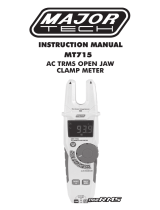17 1 8
4.11 Resistance
Resistance ranges: 660.0、6.600k、66.00k、660.0k、
6.600M、660.00M.
To measure resistance:
4.11.1 Move rotary switch to the position.
4.11.2 Connect the red test lead to the Ω jack and the
black lead to the COM jack.
4.11.3 Connect leads to circuit under test.
4.11.4 The measured resistance will be displayed.
4.12 Continuity
While in resistance mode, press “FUNC” to switch to
continuity mode.
4.12.1 Connect the red test lead to the Ω jack and the
black lead to the COM jack
4.12.2.Connect leads to circuit under test.
4.12.3.If the measured resistance is less than 50Ω, the
meter’s buzzer will sound.
4.13 Diode Test
While in continuity mode, press “FUNC” to switch to
diode mode.
4.13.1 Connect the red test lead to the V jack and the
black lead to the COM jack.
4.13.2.Connect leads across the diode under test.
4.13.3.The display shows the approx. forward voltage
drop.
Ω
4.14 Capacitance
4.15 Frequency and Duty Cycle
Frequency ranges: 60Hz, 600Hz, 6kHz, 60kHz, 600kHz,
6MHz, 60MHz.
Measuring Frequency:
4.15.1 Move the rotary switch to the Hz% position.
4.15.2 Connect the red test lead to the Hz% jack and the
black lead to the COM jack.
4.15.3 Connect the leads across the circuit under test.
4.15.4 The measured frequency will be displayed.
4.15.5 Press “FUNC” to switch to duty cycle.
4.15.6 Repeat steps 2-4 to measure duty cycle.
4.16 DC/AC Current
Current ranges: 660A, 6600A, 66.00mA, 660.0mA,
10.000A.
4.16.1 Turn off power to the circuit and discharge all
capacitors fully.
4.16.2 Move the rotary switch to the appropriate current
position (µA, mA, or A)
4.16.3 Connect the black test lead to the COM jack.If the
current to be measured is less than 600mA,
connect the red test lead to the µAmA jack.If the
current to be measured is between 600mA and
10A, connect the red test lead to the 10A jack.
Capacitance ranges: 6.6nF、66.00nF、660.0nF、
6.600F、66.00F、66.0F、6.600mF and 66mF.
Measuring capacitance:
4.14.1 Move the rotary switch to the position.
4.14.2 Connect the red test lead to the jack and the
black lead to the COM jack.
4.14.3 Connect the leads across the capacitor for
measurement
4.14.4 The measured capacitance will be displayed














